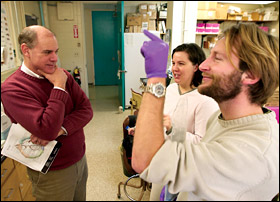
|
 |
Research > Research
Departments > Biology
Biology
Overview | Awards
& Recognition | Photos
 |
 |
| John J. Stegeman,
chair of the Biology Department (left) with postdoctoral
investigators in molecular toxicology Joanna Wilson, a
graduate of the MIT/WHOI Joint Program, and Tim Verslycke.
(Photo by Tom Kleindinst) |
Biology Department research reflects the breadth of the field: from bacteria to whales, from ocean depths to surface waters,
from fossils to newly discovered species, and from molecules
to global ecosystems. Collaborating with colleagues here and
elsewhere, WHOI biologists also develop and refine instruments
and techniques that increase the reach of science and bring
new information within our grasp.
In 2003, our biologists traveled more than ‘Seven Seas’ for
answers to scientific questions. They studied material from
the Barents, Bering, and Beaufort seas, and visited the Mediterranean,
Ross, and Sargasso seas. They sailed the Pacific and Atlantic
oceans, the Sea of Japan, and the Sea of Cortez—and spent
time in their own backyards: Long Island Sound, Georges Bank,
the Gulf of Maine, and Vineyard Sound.
Some biologists concentrated on small scales of research, while
others collaborated in large-scale national or international
research programs, such as the Southern Ocean GLOBEC (Global
Ocean Ecosystem Dynamics), ECOHAB (Ecology of Harmful Algal
Blooms), or National Oceanic and Atmospheric Administration
(NOAA) Ocean Exploration programs. Their work uses genetic,
molecular, or isotopic techniques and ranges from studying disease-causing
organisms in lobsters and clams to how whole communities and
populations of marine animals—at vents, seamounts, or
in shallower environments—are connected over distances.
Some studied genetic responses of marine organisms to environmental
pollutants, and others investigated the roles of plankton in
the cycling of elements in the ocean and atmosphere; models
of population change; or the effectiveness of marine protected
areas in maintaining populations.
Instrument development continued on several fronts. Equipment
to sample microbial life in the deep biosphere beneath the ocean
floor at hydrothermal vents was tested, as was a new suction
collector on Alvin. Data-archiving tags were used to
accumulate information about normal whale diving behavior and
responses to controlled sound experiments.
A unique instrument system installed at the Martha’s Vineyard
Coastal Observatory (MVCO) continuously monitors conditions
throughout the water column, collects and identifies images
of small animal plankton using imaging technology and artificial
intelligence, and transmits data to shore. Also at the MVCO,
a continuous automated flow system was deployed to count and
identify phytoplankton, producers in the ocean food chain. The
long-term data sets these instruments collect will reveal the
effects of local climate change on important coastal systems.
Another instrument, the Large Area Plankton Imaging System,
which produces images of larger plankton, such as jellyfish,
was successfully tested at sea.
—John J. Stegeman (jstegeman@whoi.edu)
Department Chair
|
|
